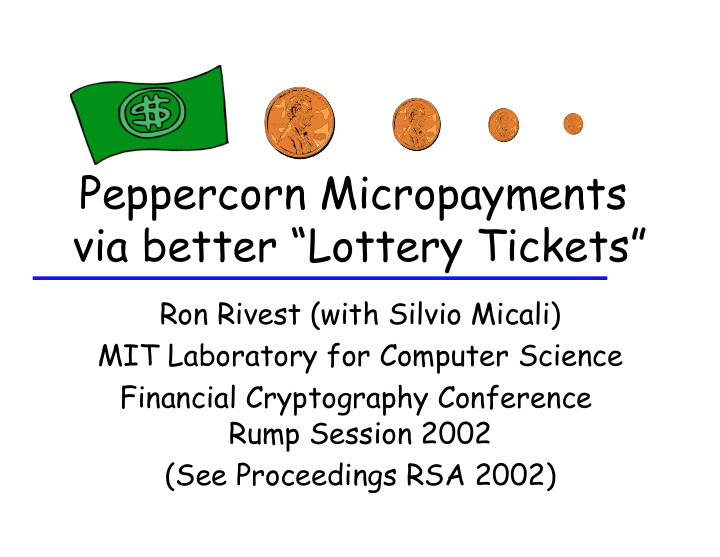



Peppercorn Micropayments via better “Lottery Tickets” Ron Rivest (with Silvio Micali) MIT Laboratory for Computer Science Financial Cryptography Conference Rump Session 2002 (See Proceedings RSA 2002)
Outline (English law says a peppercorn is smallest amount that can be paid in a contract) Talk – Improve lottery tix with two ideas: » Non-interactivity via recipient signatures » User-fairness via serial numbers Demo
The need for small payments “Pay-per-click” purchases on Web: – Music, video, information Mobile commerce ($20G by 2005) - Location-based info services, gaming, sodas, parking Infrastructure accounting: – bandwidth
Payment Framework: Payment System Provider (PSP), Bank Authori- Deposit(s) zation Payment(s) Merchant Bob User Alice
Dimensions to consider: Aggregation ( global) PSP on-line or off-line ? (off-line) Interactive vs. non-interactive (non) Computation Cost (cheap) User-fairness (fair) … (many other issues, too)
Aggregation To reduce cost, micropayments should be aggregated into fewer macropayments. Possible levels of aggregation: – None: PSP sees every payment – Session-level: aggregate all payments in one user/merchant session – Global: Payments aggregated across users and merchants Can be deterministic or statistical.
On-line vs. Off-line On-line PSP authorizes each payment or session. Off-line PSP not needed to initiate session or make payment (e.g. pay taxi)
Interactive vs. Non-interactive Interactive: Payment protocol is two-way : Non-interactive: Payment protocol is one-way (e.g. anti-spam payment in email):
Computation Cost Digital signatures are still relatively “expensive” --- but much cheaper than they used to be! It now seems reasonable to base micropayments on digital signatures. (E.g. Java card in cell phone) User and merchant are anyways involved with each transaction; digital signatures add only a few milliseconds. On-line/Off-line signature can also help.
Previous Work: Lottery Tickets “Electronic Lottery Tickets as Micropayments” – Rivest FC ’97 (similar to “Transactions using Bets” proposal by Wheeler ’96) Payments are probabilistic First schemes to provide global aggregation: payments aggregated across all user/merchant pairs.
“Lottery Tickets” Explained Assume all payments are for one cent. Merchant gives user y = hash(x) User writes check: “Pay Merchant $1 if two low-order digits of hash -1 (y) are 75.” (Signed by user, with cert from PSP.) Merchant “wins” $1 with probability 1/100. Expected value of payment is 1 cent. Bank sees only 1 out of every 100 payments. (A plus for user privacy!)
Our “Peppercorn” Proposal Peppercorn improves lottery ticket scheme, making it: – Non-interactive (by using merchant signatures) – Fair to user: user never “overcharged” (by using serial numbers)
Non-interactive Revised check: “Pay Merchant $1 if two low-order digits of the hash of Merchant’s digital signature on this check are 75.” Merchant’s deterministic signature scheme unpredictable to user. Merchant can convince PSP to pay.
Optimization for less Signing “Pay Merchant $1 if the two low- order digits of the hash of Merchant’s digital signature on the date of this check are 75.” Merchant only signs once a day.
User Fairness: No “Overcharging” Concern: unlucky user might pay $1 for his first one-cent payment! A payment scheme is user-fair if user never pays more than he would if all payments were deterministic one-cent checks.
Achieving User-Fairness User must sequence number his payments: 1, 2, … When merchant turns in winner with sequence number N, user charged N – (last N seen) cents User charged three cents for
User-Fairness (continued) Merchant is still paid $1 for each winning payment. Users severely penalized for using duplicate sequence numbers.
Conclusion Peppercorn micropayment scheme – Is highly scalable : bank supports trillions of micropayments by processing only billions of transactions – Provides global aggregation – Supports off-line non-interactive payments – Is user-fair and quite private – Uses digital signatures, but lightly.
(DEMO)
(The End)
Recommend
More recommend